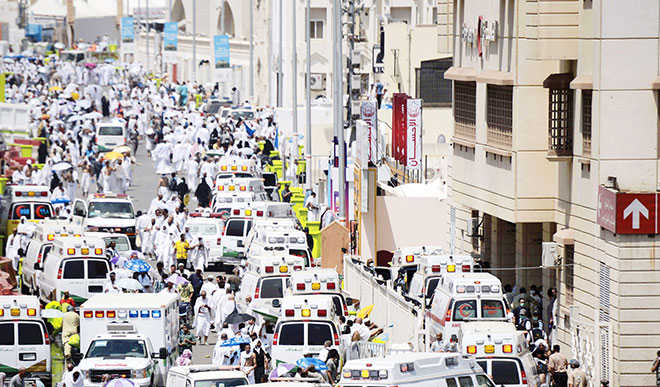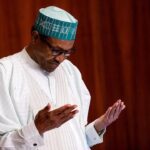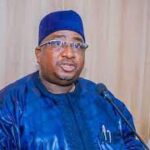
The successes recorded at the 2015 Hajj exercise paled in the face of the tragedy of the September 11 crane crash in the precinct of Ka’aba and the September 24 deadly stampede in Mina.
One of the measures taken by the Saudi Arabian government to ensure the smoothness of Hajj exercises was the reduction of the global permit for pilgrims by 20 per cent in 2013. But its implementation started in 2014, leading to the reduction of Nigeria’s slot from 95, 000 to 76, 000. Nigeria has been asking for more slots.
It was said that the reduction was meant to give room for the expansion of holy sites and upgrade facilities to accommodate the growing number of intending pilgrims.
Then came the September 11 crane collapse, which claimed the lives of six Nigerians and 105 others across the world. Three hundred and thirty-one (331) pilgrims were also injured, according to the country’s spokesperson on the two holy mosques, Ahmad Al-Mansouri.
The accident occurred when a pillar from one of the construction sites of the ongoing expansion of the mosque collapsed after a heavy rainfall, preceded by a strong wind and massive storm shortly after pilgrims had observed the Asr (late afternoon) prayer.
This was two days after our reporter arrived in the Holy Land for the double task of performing Hajj and ‘ensuring maximum coverage’ of the 2015 exercise, being a member of the media team of the National Hajj Commission of Nigeria (NAHCON).
The first floor in Makkah was designed to accommodate 278,000 worshipers while the mataf or the circumambulation area around the Kaaba would take 114,000 people at a time. Also, the Grand Mosque was scheduled to be completed before the end of September to allow pilgrims perform the tawaf (the circumambulation around the Kaaba). The space created is over 76,000 square meters, with a capacity to handle 107,000 people. In the Prophet’s Mosque in Madinah, there would be 250 umbrellas fitted, with more than 20,000 toilets. Both mosques were being designed to have 6,000 areas for ablution in the courtyards.
The stampede
Even as the dust of the crane crash was yet to settle, the deadly stampede in Mina for the Jamarat (symbolic stoning of the devil) occurred 13 days later in one of the worst recorded human calamity of modern day history. The stampede occurred about 9 am, less than 10 minutes after our reporter and 10 of his colleagues had completed their stoning at an intersection in Mina, about three miles east of Makkah.
The resolve to proceed to Makkah for the Tawaful-Ifaadah was an act of fate and Allah’s blessing as we could have been caught in the stampede if we had chosen to return to our tents in Mina.
After the 2004 Hajj, the three Jamarat, which were tall pillars, were replaced with 26-metre-long (85 feet) walls for safety as many people were accidentally throwing pebbles at others on the other side of the divide.
To give ample room for pilgrims to perform the stoning rite, the Saudi government had constructed modern elevators and carriage walkways to convey the faithful to the three floors of the holy and historic site, where Prophet Ibrahim (Abraham), Hajara (Hagar) and their son, Prophet Isma’il (Ishmael) (peace on them), stoned the shaytan (devil). The rite also represents repudiation and casting aside one’s low and based desires and wishes for uprightness and humility.
Unfortunately, despite the fact that Nigeria, through NAHCON, led by its chairman, Barrister Abdullahi Mukhtar Mohammed, the Emir of Kano and leader of the 2015 Hajj central coordinating team, Muhammadu Sanusi II, and others, the infamous stampede affected a good number of Nigerians.
Urging Nigerian pilgrims and officials to abide by whatever arrangement the Saudi authorities would make to save lives, Emir Sanusi said, “Grouping pilgrims to do the throwing and spreading the time to include the period of Zawal (sunrise) is necessary to protect lives of pilgrims. On many occasions, pilgrims have been killed at the stoning site from stampede arising out of thousands of pilgrims converging to do the throwing at the same time.
Two days later, the stampede, which many described as an act of fate occurred.
That Thursday’s historic incident is the deadliest since 1990 when 1,426 people died in a stampede in a pedestrian tunnel leading from Mecca towards Mina. The last time there were such significant casualties at the Hajj was in 2006, also in Mina, when a stampede during the stoning killed at least 346. Many others were injured in the incident.
It was one of the most trying times for me and other journalists as we battled to get information about the safety or otherwise of Nigerians from the officials of NAHCON and other stakeholders.
It became more worrisome when I learnt that some of the victims from Nigeria were related to people in the media. The Deputy Editor-in-Chief of Daily Trust titles, Mallam Mahmud Jega lost a brother, Justice Abubakar Abdulkadir Jega, who, until the incident, shared things in common with his other siblings, including the immediate past chairman of the Independent National Electoral Commission (INEC), Prof. Attahiru Jega. The late Jega was the Chief Justice of Kebbi State and a judge of the Appeal Court, Abuja.
A prominent journalist and the first female editor from the North and human rights activist, Hajiya Bilikisu Yusuf, also died in the stampede.
Also among Nigerian pilgrims who died in the stampede were the Emir of Zing and Amirul-Hajj (leader of delegation) from Taraba State, Alhaji Abbas Ibrahim Sambo and eight members from his family, the Deputy Secretary-General of the Nigeria Supreme Council for Islamic Affairs (NSCIA) and a lecturer in the University of Maiduguri, Prof. Tijjani el-Miskin, the Chief Imam of Sokoto State, among others.
Several reasons were adduced for that unfortunate incident, but Saudi’s Minister of Health, Khalid al-Falih blamed the stampede on “undisciplined pilgrims who had not followed instructions.”
Reacting to the statement from the Saudi government, chairman of NAHCON, Mohammed said: “It was not fair for anyone to blame Africans for the fatal incident.” He called on the Saudi authorities to include Nigeria in an investigation on incident.
Also reacting, the Sultan of Sokoto and president of the NSCIA, Alhaji Sa’ad Abubakar, urged Saudi authorities to henceforth provide improved safety measures during the annual pilgrimage.
On his part, Emir Sanusi called on the Saudi Arabia government to publish the details of victims on a dedicated website. He made the call at the post Arafat conference at the Nigeria Consulate office, Jeddah.
“At this age of technology, why can’t the Saudi authority put the photos of the dead on a website so that people can identify them easily? We have to demand for it,” he said.
NAHCON’s head of medical team, Dr. Ibrahim Kana, however, said that over 2,000 bodies were identified through frontal and lateral face photographs and fingerprints. He further observed that many died as a result of the excessive heat in the kingdom, which easily led to exhaustion and dehydration, and urged the remaining pilgrims waiting to be airlifted to stay indoors so as to prevent heat stroke and other ailments associated with excessive heat. They were also advised to take a lot of water, use umbrella and eat good food to stay healthy.
Also commenting on the crane crash and the stampede, director of the Muslim Rights Concern (MURIC), Prof. Isiaq Akintola, urged Nigerians to pray for the safe of pilgrims.
“Pilgrims need our prayers. There are several challenges facing us right now. The weather has never been this hot in Saudi. It is now 46 degrees. People sometimes find it difficult to breathe. I was saved by Allah because I took the same route barely 30 minutes earlier.
“Egyptian pilgrims are mostly to blame for what happened because they insisted on taking the same route to return to their camp after throwing their own stones. They faced us and the road became impassable. We were trapped at one spot for several minutes. We were suffocating gradually and Saudi policemen had to start throwing water at us to help us to breathe. It was Allah that saved us.
“This is criminal negligence and the Saudi authorities must be held accountable. We urge the Nigerian government to support NAHCON’s stand on this. Nigeria must demand compensation from the Saudis for families of the bereaved. We should also task them to involve the world Muslim Ummah in the planning and implementation of the annual Hajj exercise,” Akintola said.

 Join Daily Trust WhatsApp Community For Quick Access To News and Happenings Around You.
Join Daily Trust WhatsApp Community For Quick Access To News and Happenings Around You.


